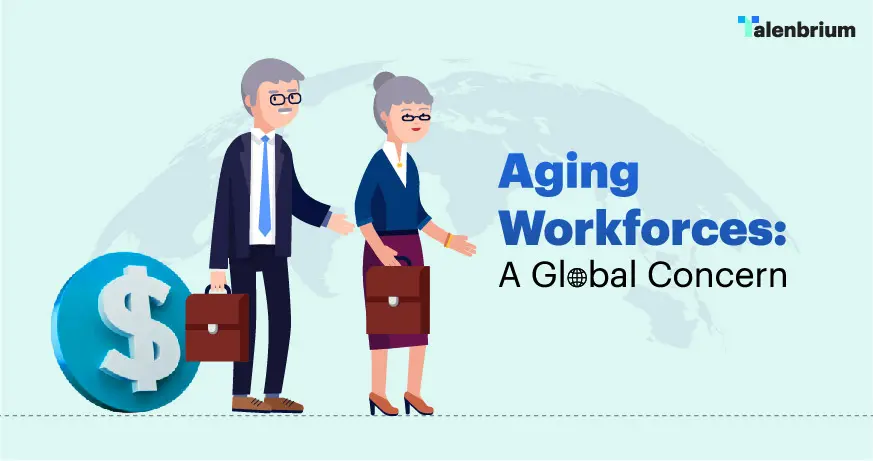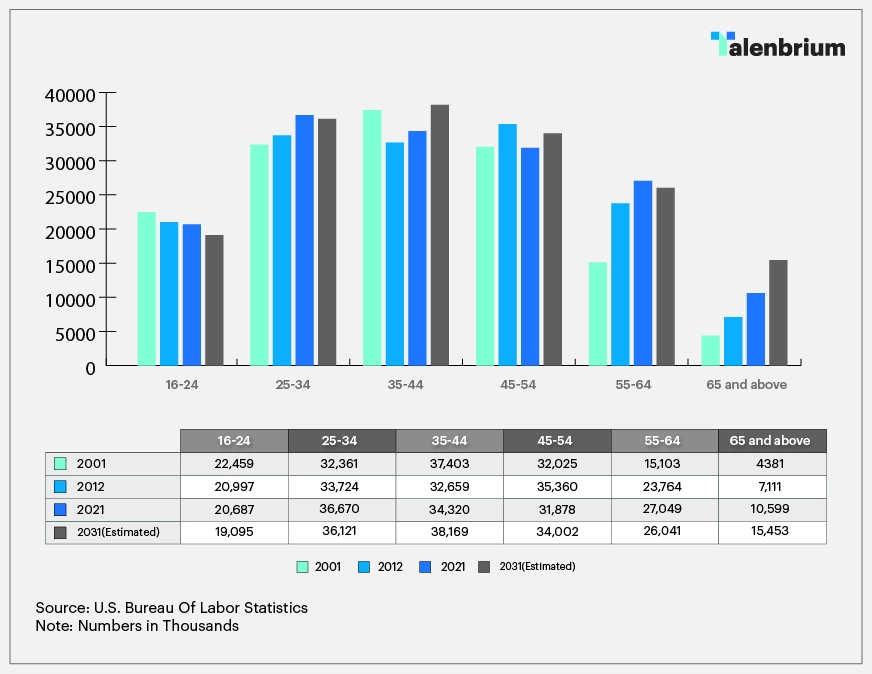Contact Us

Conspicuous surge in the aging labor force over the decades has raised concerns regarding its socioeconomic impact across the globe.
Conspicuous surge in the aging labor force over the decades has raised concerns regarding its socioeconomic impact across the globe. In the U.S. ten thousand baby boomers turn 65 every day, a trend which is expected to continue till the end of the 20s of the 21st century (United States Census Bureau). The “Silver Tsunami” has severe implications on labor productivity as it raises concerns about mass retirement and the need to replace the gap. Economic productivity is affected as this group has accumulated substantial experience over the years which affects the quality of work.
The below data from the U.S. Burea of Labor Statistics tracks the active work force in different age groups throughout the years. The graph highlights a steady increase in the population above 65 years over the years and a slight reduction in younger workforce, creating concerns about shortage of manpower in the future.

Aging workforce results in slow economic growth of the labor force which slows down GDP and strains public budget as cost of health and retirement programs goes up. As older workforce increases, it raises the possibility of mass retirement, thus resulting in reduction of labor force, and lower productivity. Shortage in workforce can result in wage inflation which could contribute to uncertain and volatile economy on a global scale. Growth in per capita output was a confluence of average annual economic growth and population growth globally. But a large number of older population risks disrupting the balance.
This group is less likely to learn new skills which limits innovation. Older population finds it difficult to acclimatize to changing environments and with rapid advancement in technology, the need to adapt has increased significantly. However, many see it as an incentive to accelerate implementation of automation which, in turn, increases productivity by eliminating the need for human workers and eradicating the prospect of human error.
Another economic consequences of aging include high cost of supporting older citizens, burdened by society. As this phenomenon is common in developed countries, governments there are taking measures to reduce potentially devastating impacts. Several nations have raised the bar on the age of retirement. This not only increases productivity and contributes to the national coffer but also limits expenses in social programs for the elderly. Few countries are inviting migrant workers to fill the gap. This helps the economies of both sending and receiving countries.
Socio impact includes impact on health, behavior, family structure, and relation between generations. Although several people are choosing to work even after retiring, their impending retirement is expected to increase dependency rate of the country. The younger generation will have to support more family members, which affects both personal and professional aspects of their lives. Need for proper welfare of this age group dictates an active age-friendly community, social programs, and activities to foster relationships and avoid isolation, all of which imply dollars out of government funds.
Technological advancements have led to a longer and healthier lifespan. Most of the older population continue to work owing to either financial strain or simply the need to be productive. As per the white paper published by the Cabinet Office, Government of Japan in 2020, 71% of “60-64” age group people are in employment as compared to 62.2% in 2017. The numbers are rising steadily with 10.4% of “75 and above” age group in workforce in 2020, whereas the figure stood at 9% in 2017. Health life expectancy at birth is not only increasing the overall life expectancy of the population in the country but also affecting the population willing to work even after retirement. It can also be seen that adoption of automation is faster in countries where percentage of older population is higher. Dearth of younger generation to fill the gap left by older workforce in a few years has encouraged adoption of robots by private and public countries. The need to maintain productivity has encouraged integration of automation as an alternative to human workforce. South Korea is leading in terms of deployment of automation and robotics. The country also has one of the largest older workforce at approximately 69% of the 55-64 age group in 2023 (OECD).
Countries currently reaping the benefits of having a “young workforce” will most likely face similar concerns over the older workforce in a few decades. These countries can gain meaningful insight into how to approach the quandary from countries facing the problem currently, such as Japan, South Korea, Germany, and the U.S., among others.
Your email address will not be published. Required fields are marked *